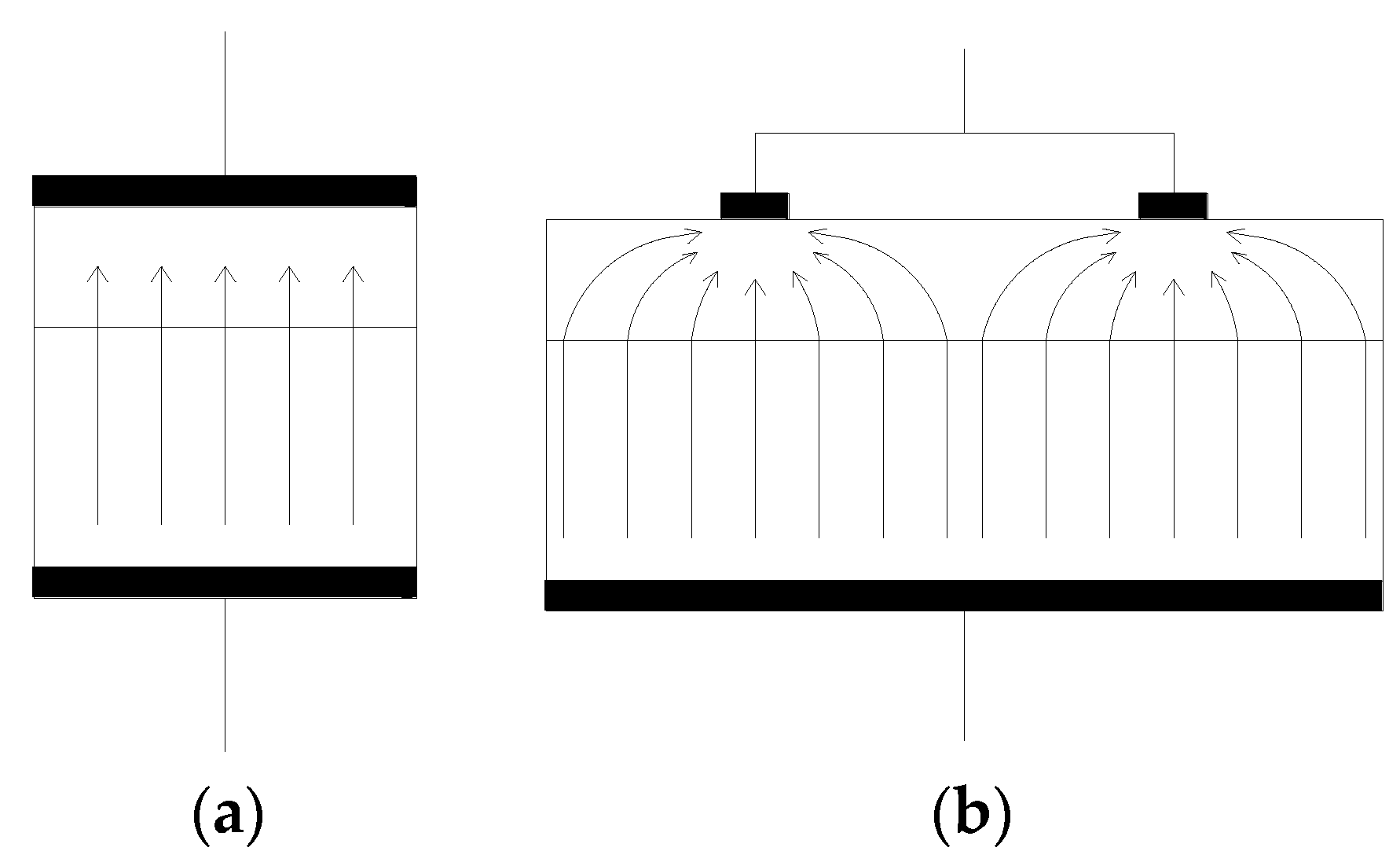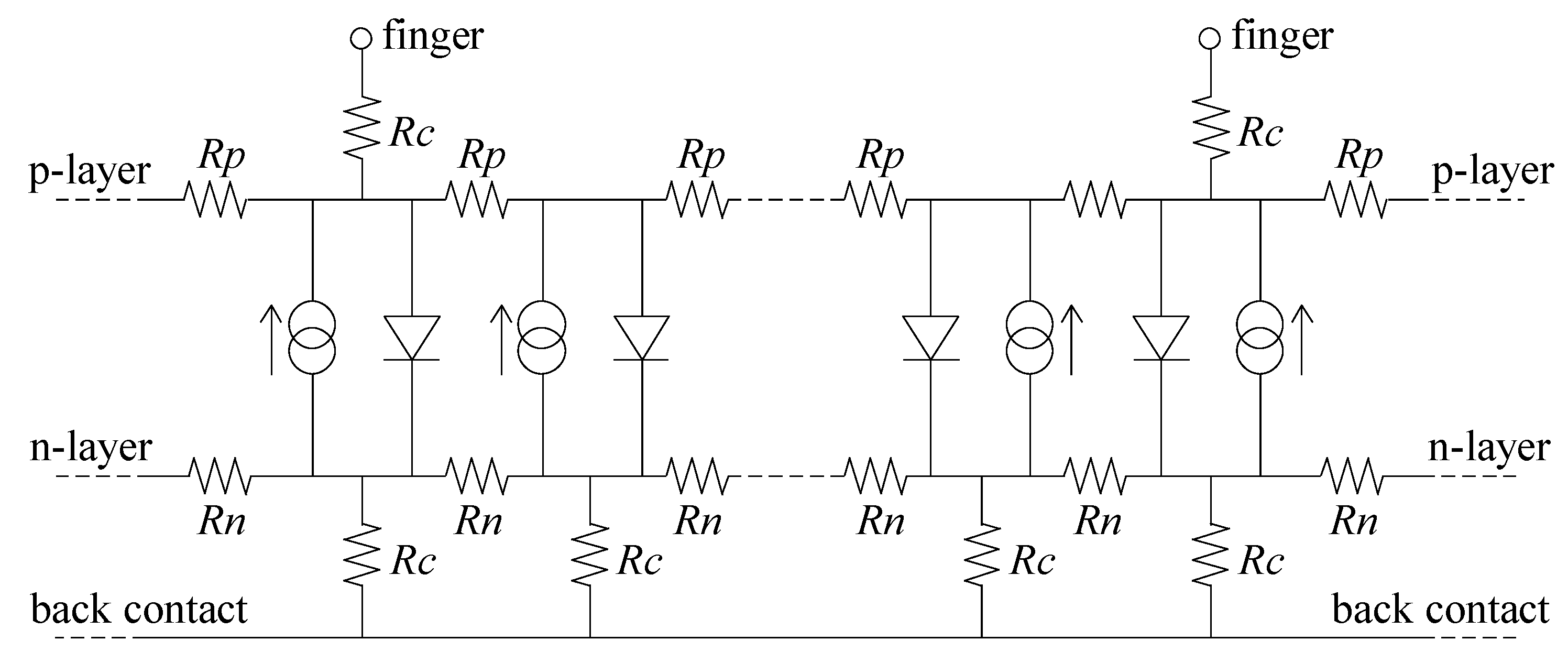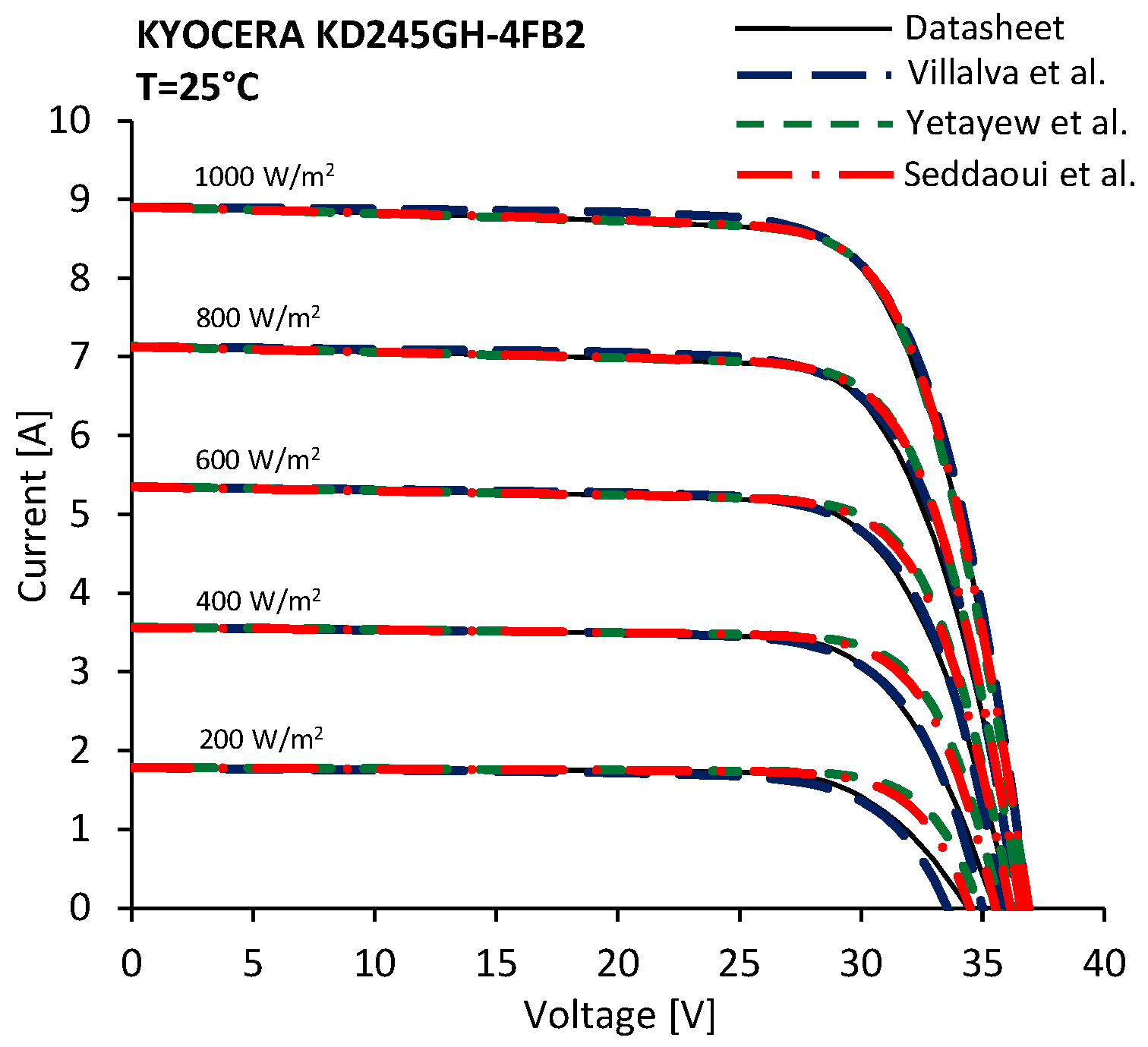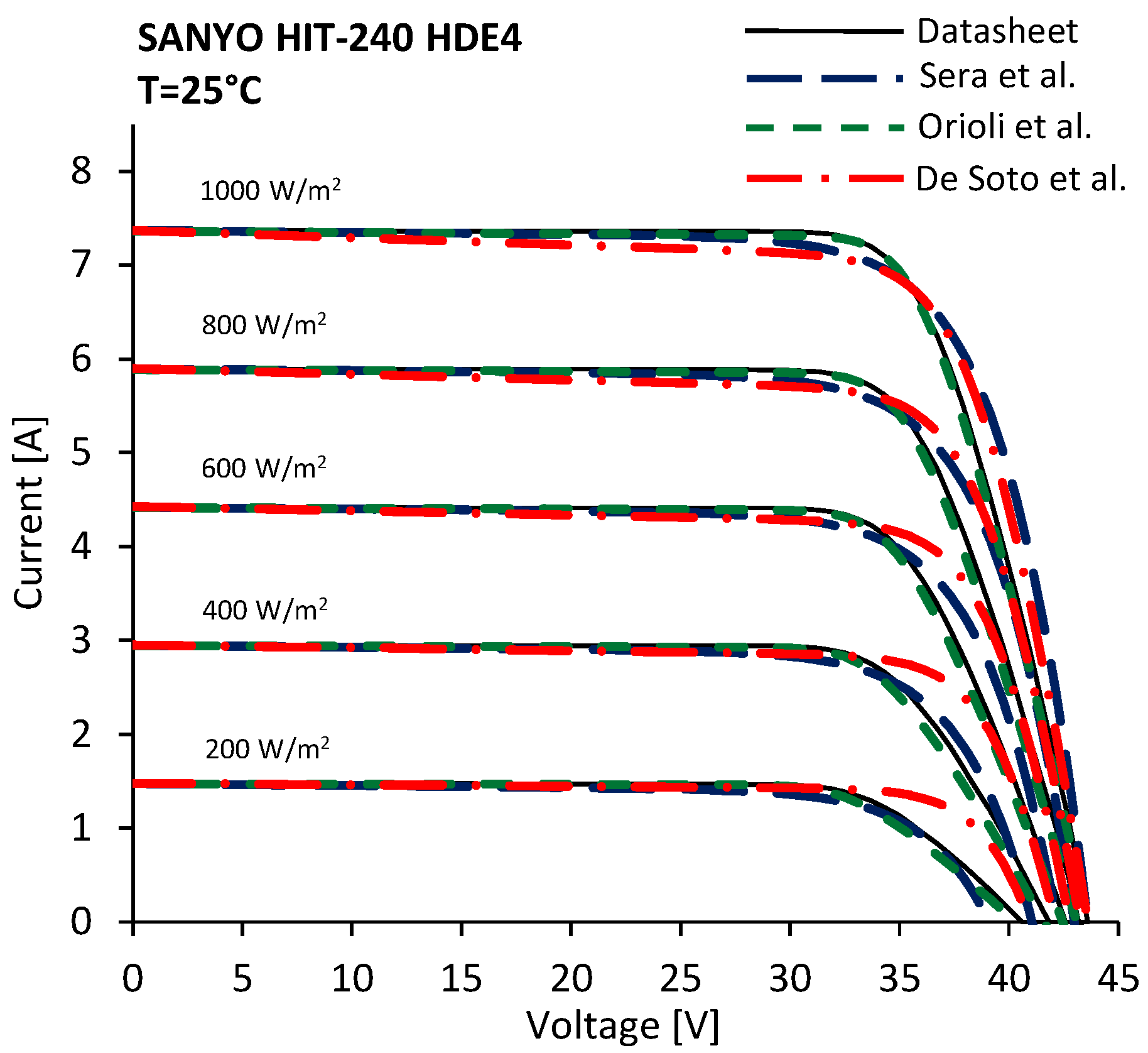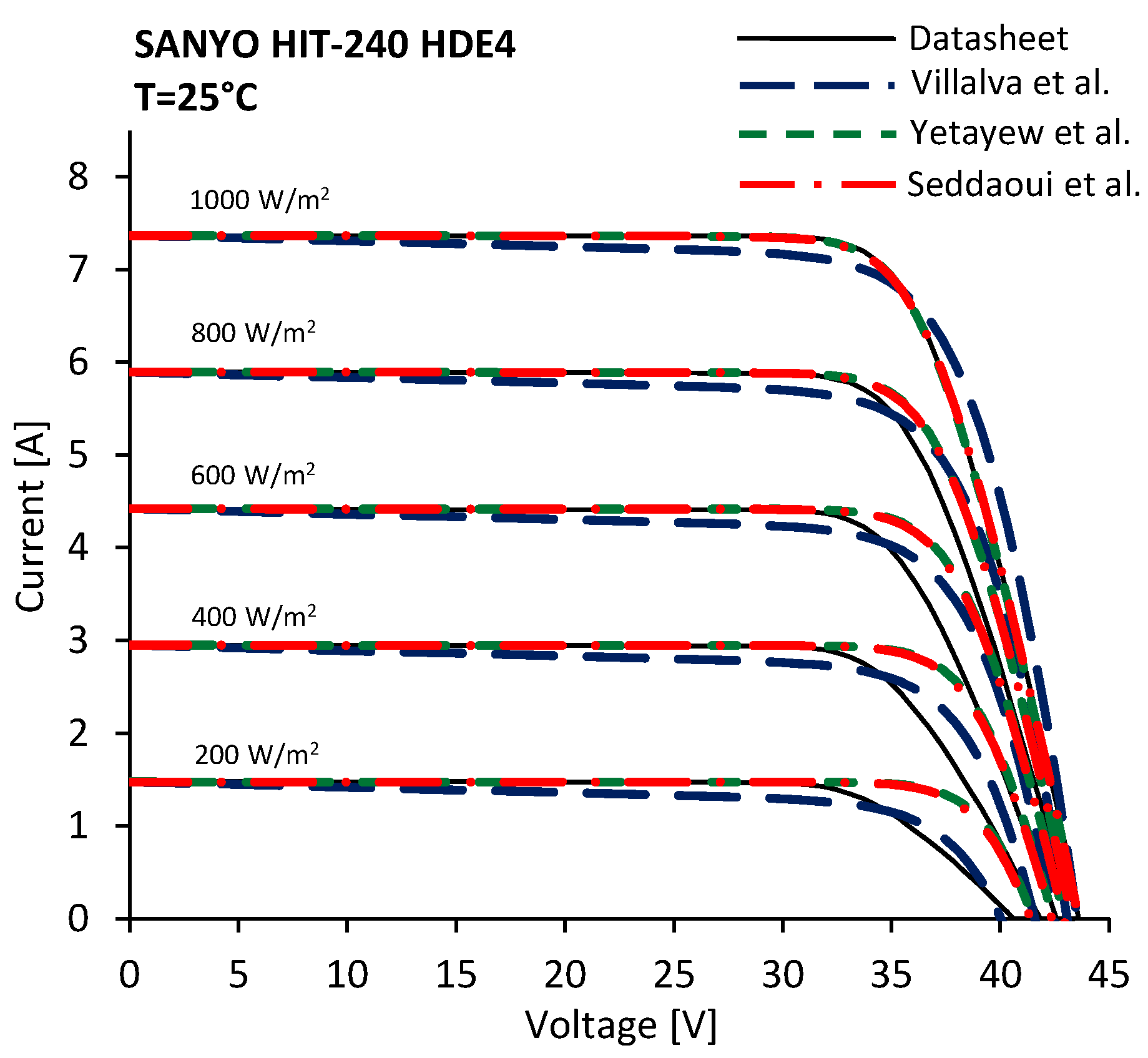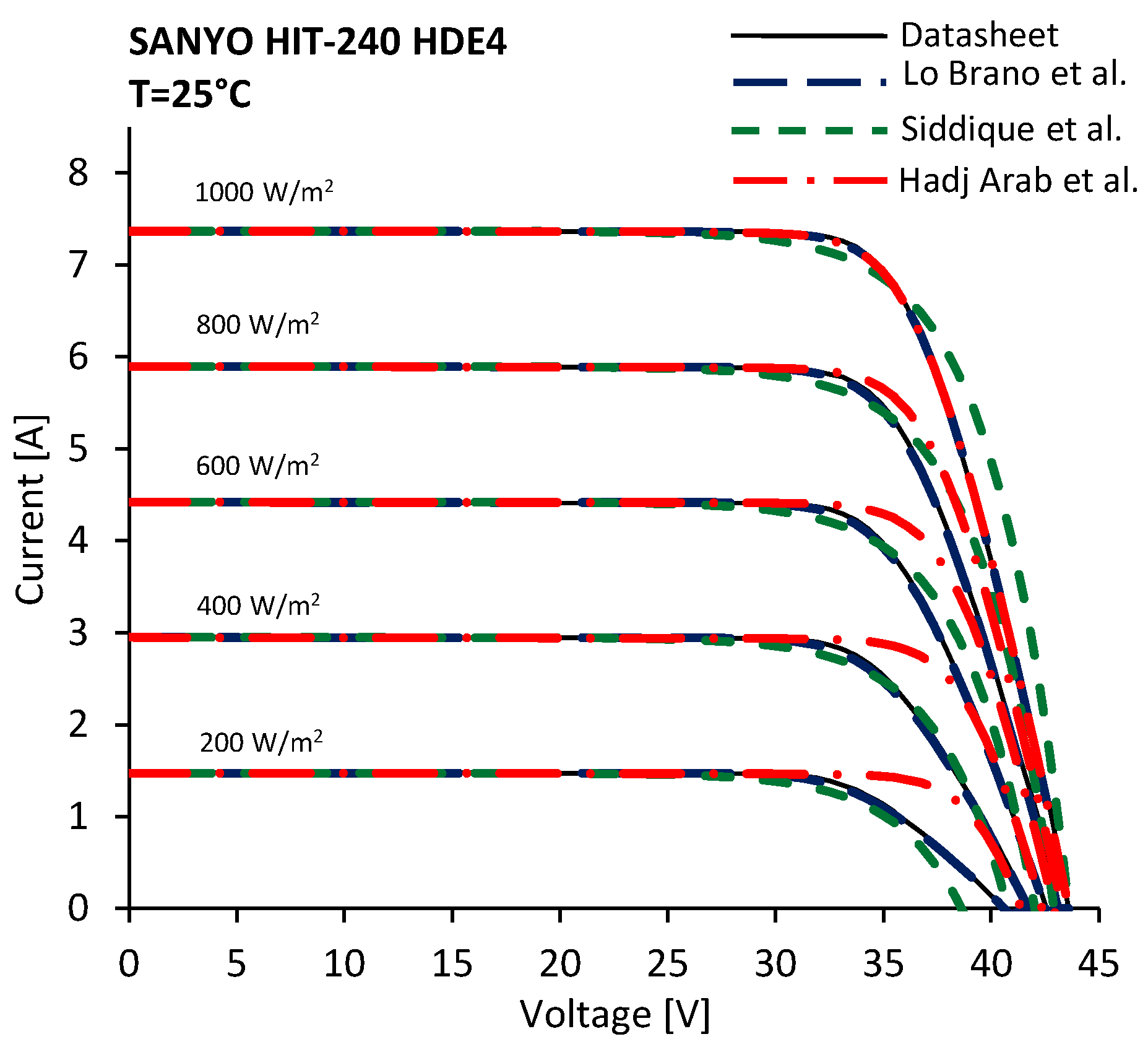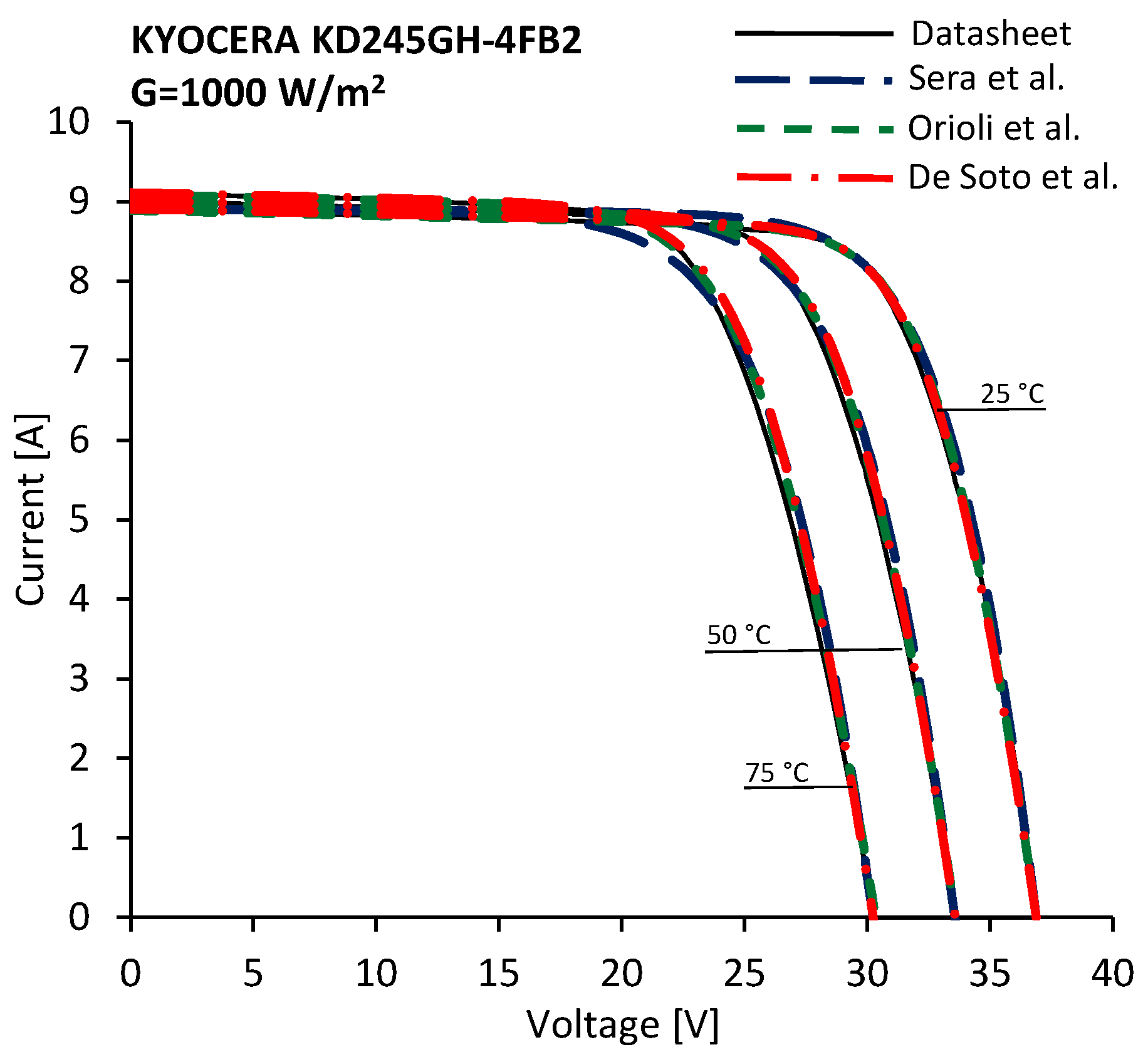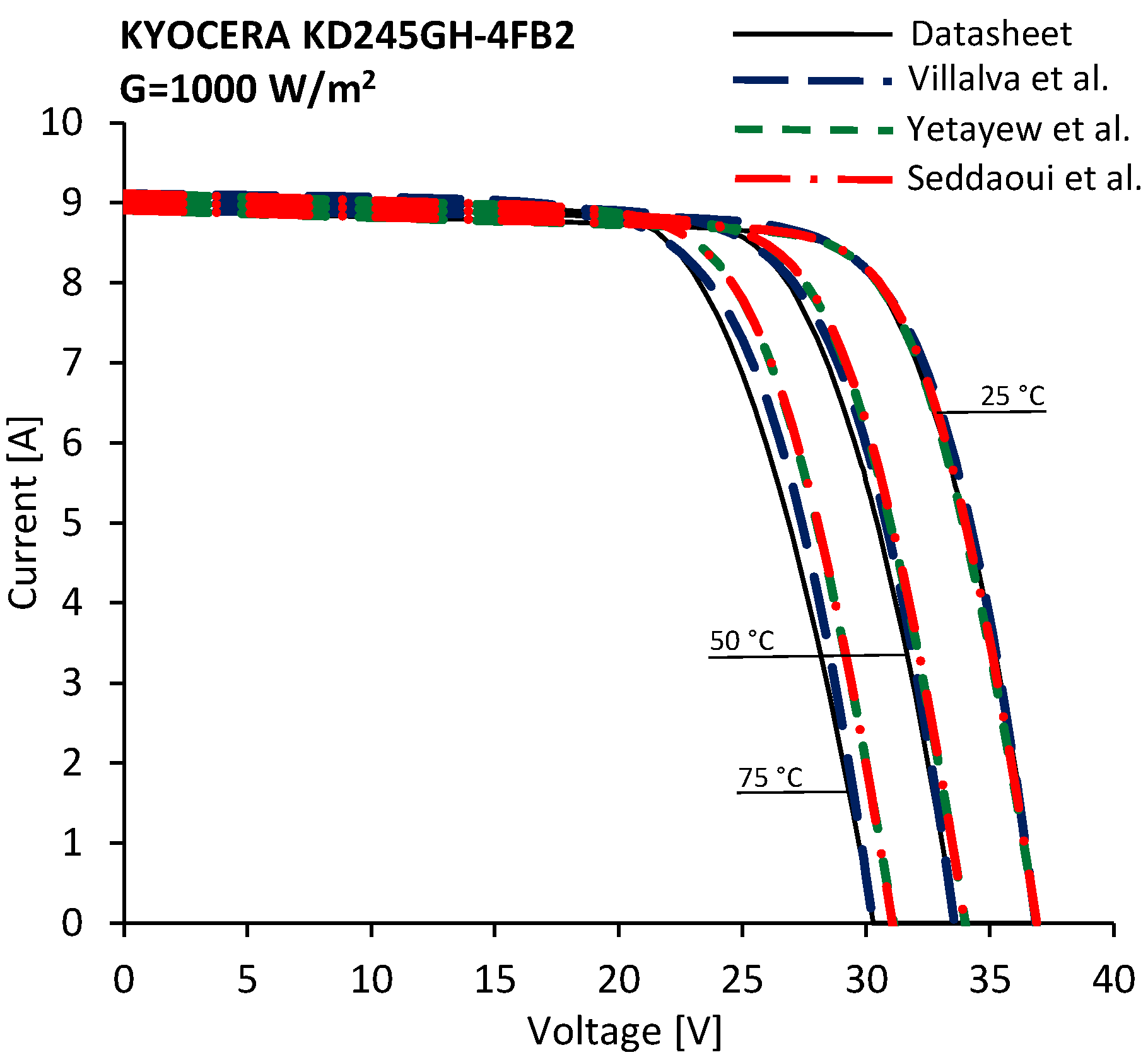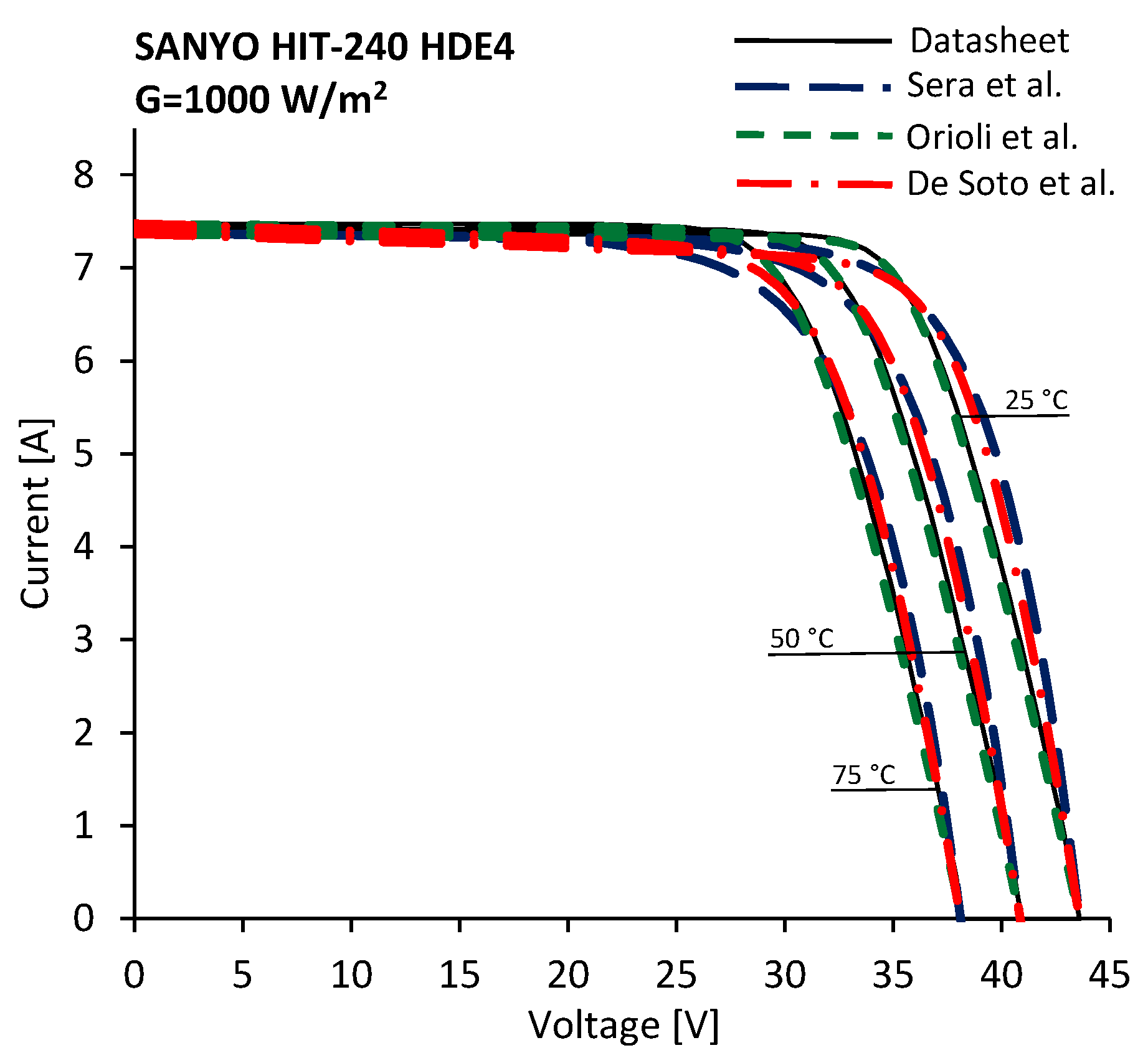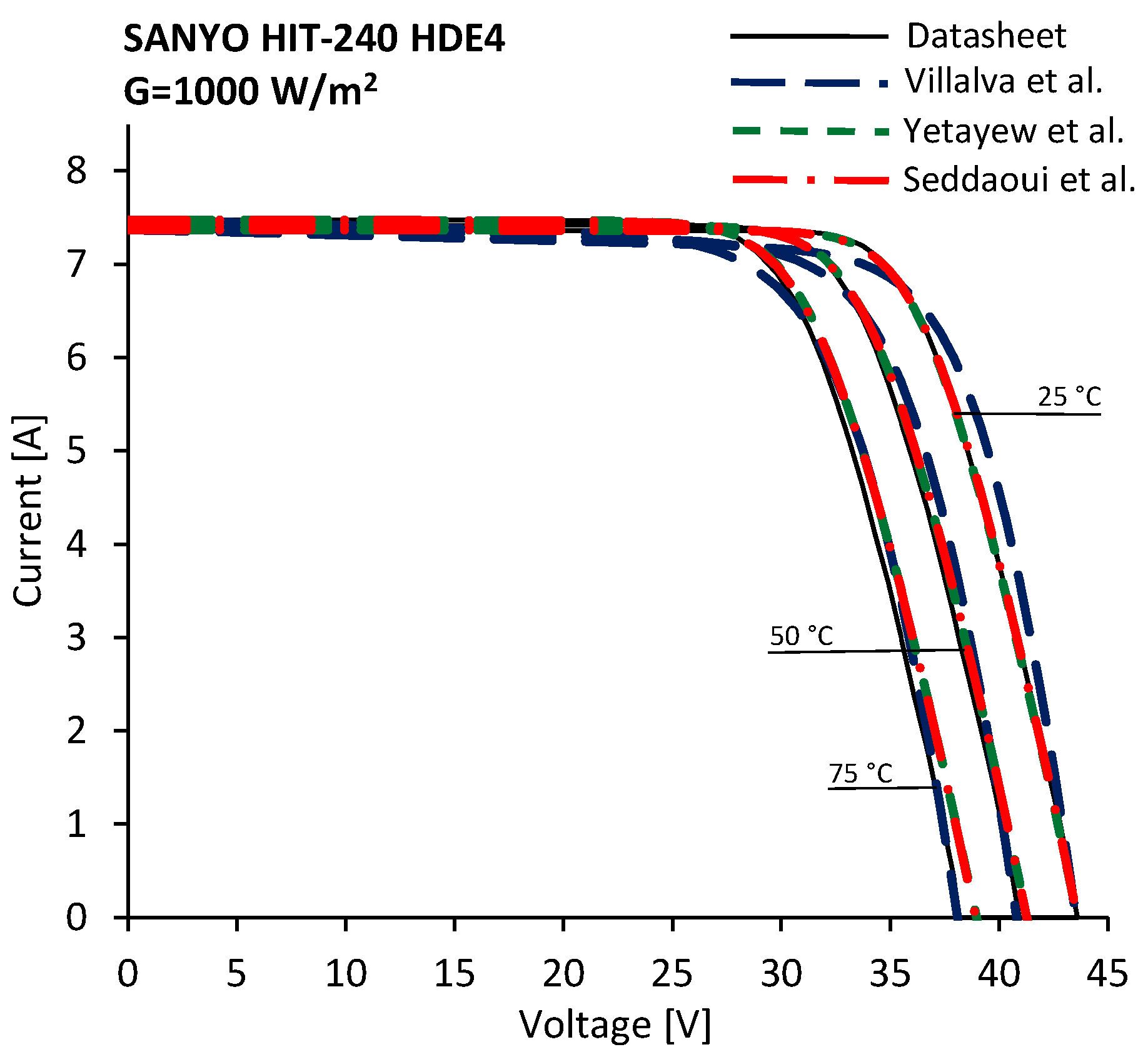1. Introduction
In the field of photovoltaics, the diode-based equivalent circuits of photovoltaic (PV) cells and modules have been widely used because they allow the designer to optimize the system performance and maximize the effectiveness of the economic investment. The use of accurate models of the electrical behaviour of PV modules, which is obviously important to implement simulation tools, is also required to test the dynamic performances of the inverters equipped with the maximum power point tracker (MPPT). In order to get results, which would be confirmed by experimental measurements, the practical effectiveness of MPPT control algorithms was analysed using different diode-based equivalent circuits [
1,
2,
3]. It was observed that the study of the transient conditions, which are quite common for an MPPT, requires very reliable equations describing the behaviour of the PV array working far from the standard rating conditions [
4].
Usability and accuracy, which have been already addressed by other authors [
5], are important features that have to be carefully considered before deciding the mathematical model to be adopted to simulate the electrical behaviour of PV devices. The usability is mainly affected by the mathematical difficulties, which may be encountered in performing calculations, and the unavailability of the performance data used to evaluate the model parameters. Before starting working, it would be preferable to have a clear idea about the need of specific performance data, which may be not available or difficult to extract from the issued datasheets, and the computation difficulties, which may require the use of mathematical tools ranging from simple algorithms to complex methods implemented in dedicated computational software. Also the accuracy is a relevant parameter, even though its achievable level may significantly depend on the physical characteristics of the modelled PV devices.
To better understand the origin of the diode-based equivalent circuits used for modelling PV devices it is useful to remember that, like a semiconductor diode, a PV cell consists of two layers of semiconductor material, usually silicon, differently doped, that are electrically connected to two metallic electrodes deposited on their outer surfaces. To better understand the origin of the diode-based equivalent circuits used for modelling PV devices it is useful to remember that a PV cell is a diode made with two layers of semiconductor material, usually silicon, differently doped, that are electrically connected to two metallic electrodes deposited on their outer surfaces. It is well-known [
2,
6] that the absorption of light in semiconductors can, under certain conditions, create an electric current due to the capability of the absorbed photons of converting fixed electrons in freely moving conduction electrons.
A silicon PV cell shares with semiconductor electronic devices, such as diodes and transistors, the same processing and manufacturing techniques used to create p-n junctions. An ideal PV cell behaves like an illuminated semiconductor diode whose
I-V characteristic was described by Shockley [
7] with the following equation:
where
I and
V are the current and voltage,
IL is the photocurrent generated by illumination,
I0 is the reverse saturation current of the diode,
q is the electron charge (1.602 × 10
−19 C),
k is the Boltzmann constant (1.381 × 10
−23 J/K),
T is the junction temperature and diode ideality factor γ, in compliance with the traditional theory of semiconductors [
8], is 1 for germanium and approximately 2 for silicon.
Wolf [
9] observed that in a PV cell the photocurrent is not generated by only one diode but it is the global effect of the presence of a multitude of elementary flanked diodes that are uniformly distributed throughout the surface that separates the two semiconductor slabs of the p-n junction. The assertion of Wolf arises from a significant difference between diodes and PV cells: unlike semiconductor diodes, the upper electrode of a PV cell is deposited with a discontinuous structure that embeds several metal elements (fingers), whose shape and size are chosen with the aim of maximizing the absorbing surface and minimizing the contact resistance between fingers and silicon. In a real diode the electrodes face each other and the carriers of electricity flow through the silicon slabs following linear paths, which are perpendicular to the junction. In contrast, into a PV cell, because of the discrete shape of the upper electrode, the carriers of electricity follow curved paths toward the fingers that collect them (
Figure 1).
As a result of the unequal length of the current paths, the carriers of electricity flow through different thicknesses of semiconductor and different electrical resistances are thus opposed. As consequence, each elementary portion of the p-n junction has a different electrical behaviour and, in turn, a different
I-V characteristic. In order to get a realistic representation, a PV cell may be approximated with the distribute constants electric circuit of
Figure 2, which contains a multitude of elementary lumped components composed of a current generator and a diode. Numerous electrical resistances take account of various dissipative effects. Major contributions to the internal series resistance come from the sheet resistance of the p-layer, the bulk resistance of the n-layer and the resistance between the semiconductor layers and the metallic contacts.
The elementary diodes are inter-connected by resistors Rp and Rn, which represent the transverse distributed resistances of p-layer and n-layer, respectively; resistors Rc are included to consider the contact resistance between the semiconductor and the fingers, or the back contact. Because such equivalent circuit would be too complex to be used, simplified equivalent circuits, which contain one or two diodes, a current generator and two resistors, were considered.
Many authors have proposed analytical procedures for determining the model parameters on the basis of the performance data usually provided by manufactures [
10,
11,
12,
13,
14,
15,
16,
17,
18,
19,
20,
21,
22,
23,
24,
25,
26,
27,
28,
29,
30,
31,
32,
33,
34,
35,
36,
37,
38,
39,
40,
41,
42,
43,
44,
45,
46,
47,
48,
49,
50,
51,
52,
53,
54,
55,
56,
57]. The identification of the parameters contained in the diode-based equivalent circuits has been also tackled exploring the possibility of using different procedures such as Lambert
W-function, evolutionary algorithms, Padè approximants, genetic algorithms, cluster analysis, artificial neural networks, harmony search-based algorithms and small perturbations around the operating point [
58,
59,
60,
61,
62,
63,
64,
65,
66,
67,
68,
69]. One-diode and two-diode models have been also used to describe the electrical behaviour of PV modules built with different technologies, such as thin-film PV cells and panels [
17,
18,
47,
49,
66,
70,
71,
72,
73,
74,
75,
76,
77,
78,
79,
80,
81,
82].
Because of the amount of combinations that can be obtained by changing the used set of performance data, the adopted hypotheses and the analytical procedures for evaluating the model parameters, a great number of one-diode models have been reported in the scientific literature. The selection of the model fit for purpose may be a difficult task, which cannot disregard some important aspects, such as:
the kind and availability of the performance data used by the model;
the reliability of the hypotheses on which the model is based;
the procedure followed to obtain the expressions used to calculate the model parameters;
the mathematical methods, tools and/or computer routines required to solve the equation system;
the robustness and stability of the mathematical approach;
the achievable precision of the model.
The features mentioned above affect the model effectiveness and change its usability rating and accuracy level. The usability is a qualitative parameter, whereas the accuracy achievable by a model requires a quantitative assessment. An aware choice of the one-diode model, which should be the best compromise between analytical complexity and expected accuracy, would require the capability of performing the complex synthesis of both qualitative and quantitative features. In order to help researchers and designers, working in the area of photovoltaic systems, to select the model fit for purpose, the usability and accuracy of some of the most famous one-diode models are overviewed and rated in this study. The paper is organised as follows:
Section 2 presents the five-parameter equivalent circuit. To assess the usability rating the analytical procedures of some one-diode models are synthetically reviewed in
Section 3 along with the used performance data, the required mathematical tools and the operative steps to obtain the model parameters. In
Section 4, the accuracy of the tested one-diode models is evaluated by calculating the
I-V characteristics of some PV modules and comparing them with the performance curves issued by manufacturers. A criterion for rating the usability and accuracy of the analysed one-diode models is presented in
Section 5. Moreover, the model, which represents the ideal compromise between the usability and accuracy is highlighted. The
appendix lists the detailed descriptions of the procedures used by the ranked models and the explicit or implicit expressions necessary to evaluate the model parameters; such a review also contains the sequence of operative steps to easily calculate the model parameters.
2. The One-Diode Equivalent Circuit
The one-diode equivalent circuit depicted in
Figure 3 is characterized by five parameters, which are photocurrent
IL, diode reverse saturation current
I0, series resistance
Rs, shunt resistance
Rsh, and diode quality factor
n =
aNcsk/q, in which
a is the shape factor,
Ncs is the number of cells of the panel that are connected in series,
q is the electron charge (1.602 × 10
−19 C) and
k is the Boltzmann constant (1.381 × 10
−23 J/K).
The one-diode model is described by the well-known equation:
where
T is the cell temperature. Following the traditional theory, the photocurrent depends on the solar irradiance and the diode reverse saturation current is affected by the cell temperature. The values of
Rs,
Rsh,
n and
I0 variously affect the
I-V characteristic of the PV panel [
83]. The series and shunt resistances take account of dissipative phenomena and parasitic currents within the PV panel.
At a constant value of the solar irradiance, the internal dissipation of energy is reduced if the series resistance is lowered and/or the shunt resistance is increased. As a consequence, the panel becomes more efficient because the maximum power point (MPP) slides towards right and the I-V curve becomes sharper. Thin-film PV cells and modules, which present significant values of Rs and Rsh due to the use of materials that are more energy dissipative than the mono or poly crystalline silicon, are usually characterized by smooth I-V curves.
The analytical procedures proposed to calculate the five-parameter model generally require the following data, some of them are provided by the manufacturer datasheets:
open circuit voltage Voc,ref and short circuit current Isc,ref at the standard rating conditions (SRC): irradiance Gref = 1000 W/m2, cell temperature Tref = 25 °C and average solar spectrum at AM 1.5;
voltage Vmp,ref and current Imp,ref in the MPP at the SRC;
open circuit voltage temperature coefficient μV,oc and short circuit current temperature coefficient μI,sc;
number Ncs of series connected PV cells;
the derivative of the I-V curve calculated at the maximum power, short circuit and open circuit points.
Because of the presence of current I in both terms of transcendent Equation (2), the solution of the five-equation system, which is necessary to calculate the model parameters, cannot be faced by means of exact mathematical methods. For this reason, both numerical calculation techniques and approximate forms of the equations were adopted.
4. Accuracy of the One-Diode Models
In order to assess the accuracy of the proposed procedures, a comparison between the tested one-diode models was made using the
I-V characteristics extracted from manufacturer datasheets by reading the coordinates of a large number of points on each curve. For the sake of brevity, only two PV modules, based on different production technologies, were considered. Obviously, because the results are strongly affected by the particular shape of the considered
I-V characteristics, a more reliable assessment may require the use of a greater number of PV modules. Actually, the aim of this accuracy assessment is not ranking the best or the worst among the analysed models, but only reckoning the range of predictable precision in order to calibrate the proposed criterion. The data of the simulated PV modules are listed in
Table 2.
The Lo Brano
et al. and the Orioli
et al. models also use the open voltage at
G = 200 W/m
2 and
T = 25 °C, which are 34.40 V and 40.61 V per the Kyocera and the Sanyo PV modules, respectively. To calculate parameter
K, these models use the values of voltage and current at the MPP for
G = 1000 W/m
2 and
T = 75 °C, which are 22.50 V and 8.35 A, for the Kyocera PV panel, and 28.89 V and 7.13 A, for the Sanyo PV module. In order to get a reliable comparison between the calculated and the experimental data, numerous points were extracted from the
I-V characteristics issued by the manufacturer, considering both the constant solar irradiance and the constant cell temperature curves. To calculate
Rsho and
Rso, the reciprocal of slopes of the
I-V curve in correspondence of the short circuit and open circuit points were extracted from the issued
I-V characteristics following the graphical procedure described in [
44].
Table 3 and
Table 4 list the values of the parameters evaluated with the analysed models.
The values of
Table 3 and
Table 4 were used to calculate the
I-V characteristics of the selected PV panels. In
Figure 4,
Figure 5,
Figure 6,
Figure 7,
Figure 8 and
Figure 9 the
I-V curves evaluated at
T = 25 °C with the models of Hadj Arab
et al., De Soto
et al., Sera
et al., Villalva
et al., Lo Brano
et al., Seddaoui
et al., Siddique
et al., Yetayew
et al. and Orioli
et al. are compared with the characteristics issued by manufacturers.
Because the Hadj Arab
et al. and the Seddaoui
et al. are based on the same information, it is not surprising that the
I-V curves at the SRC resulted quite similar. Conversely, significant differences are expected for values of solar irradiance and temperature different from the SRC.
Figure 10,
Figure 11,
Figure 12,
Figure 13,
Figure 14 and
Figure 15 depict the
I-V curves evaluated at
G = 1000 W/m
2 and the characteristics issued by manufacturers.
It can be generally observed in
Figure 4,
Figure 5,
Figure 6,
Figure 7,
Figure 8,
Figure 9,
Figure 10,
Figure 11,
Figure 12,
Figure 13,
Figure 14 and
Figure 15 that most of the models result less accurate for values of voltage greater than the MPP voltage. Moreover, it can be inferred that the one-diode models are more precise if they are used to evaluate the
I-V characteristics of the Kyocera PV panel. This occurrence may be due to the different shape of the
I-V curves used to compare the analysed models. It can be also observed that models that use similar values of the parameters listed in
Table 3 and
Table 4 yield different
I-V curves for values of the solar irradiance and the cell temperature far from the SRC because different approaches were adopted to describe the effects of the solar irradiance and cell temperature. To quantify the accuracy of the analysed models, the mean absolute difference (MAD) for current and power was calculated with the following expressions:
in which
Viss,j and
Iiss,j are the voltage and current of the
j-th point extracted from the
I-V characteristics issued by manufacturers,
Icalc,j is the value of the current calculated in correspondence of
Viss,j and
N is the number of extracted points. Moreover, in order to assess the range of dispersion of the results, also the maximum difference (MD) for current and power was evaluated using the following relations:
Table 5 and
Table 6 list the MAD(
I)s and MAD(
P)s for the Kyocera KD245GH-4FB2 and Sanyo HIT-240 HDE4 PV panels.
Considering the solar irradiance variation, if the Hadj Arab et al., the Villalva et al., the Lo Brano et al. and the Seddaoui et al. models are used for the Kyocera PV panel, MAD(I)s ranging from 0.041 A to 0.054 A can be obtained. In the same conditions, the MAD(P)s vary from 1.074 W to 1.769 W. For the Sanyo PV module, the smallest MAD(I)s, which occur when the Hadj Arab et al., the Lo Brano et al. and the Seddaoui et al. models are used, vary between 0.015 A and 0.041 A. The smallest MAD(P)s derived from the same models. These differences vary between 0.487 W and 1.601 W. The greatest MAD(I)s for the Kyocera PV panel, which are calculated with the Siddique et al. and the Yetayew et al. models, vary from 0.136 A to 0.253 A. The Yetayew et al. model yields the greatest MAD(P)s, which range from 4.387 W to 8.123 W. For the Sanyo PV module, the greatest MAD(I)s are noted for the De Soto et al., the Siddique et al. and the Yetayew et al. models. These differences are contained in the range from 0.251 A to 0.346 A. The greatest MAD(P)s, which belong to the same models, vary from 9.427 W to 13.321 W.
At constant solar irradiance, if the Hadj Arab
et al., the Lo Brano
et al. and the Seddaoui
et al. models are used for the Kyocera PV panel, MAD(
I)s ranging from 0.042 A to 0.063 A can be observed. In the same conditions, the MAD(
P)s vary from 1.333 W to 1.611 W. For the Sanyo PV module, the smallest MAD(
I)s, which are obtained from the Hadj Arab
et al., the Lo Brano
et al. and the Seddaoui
et al. models, vary between 0.021 A and 0.034 A. The smallest mean power differences are obtained from the same models. These differences vary between 0.828 W and 1.142 W. For the Kyocera PV module, the greatest MAD(
I)s are generated by the Seddaoui
et al. and the Siddique
et al. models. These differences are contained in the range from 0.166 A to 0.655 A. The greatest MAD(
P)s, which are obtained from the Seddaoui
et al. and the Yetayew
et al. models, vary between 6.625 W and 18.222 W. The greatest MAD(
I)s for the Sanyo PV panel, which are obtained from the Sera
et al. and the Siddique
et al. models, vary from 0.273 A to 0.337 A. The Siddique
et al. and the Yetayew
et al. models yield the greatest MAD(
P)s, which range from 8.991 W to 13.321 W of the issued rated maximum power. In
Table 7 and
Table 8 the values of MD(
I) and MD(
P) for the analysed panels, calculated considering the
I-V curves at a constant cell temperature of 25 °C, are listed.
Considering the
I-V curves at constant temperature for the Kyocera PV panel, the Lo Brano
et al. model seems to be the most accurate; the MD(
I)s vary from −0.257 A to 0.132 A. The greatest current differences, which are contained in the range −0.574 A to 0.636 A, are observed for the Siddique
et al. and the Yetayew
et al. models. The smallest MD(
I)s are obtained for the Sanyo PV module from the Hadj Arab
et al., the Lo Brano
et al. and the Seddaoui
et al. models; these differences are in the range −0.040 A to −0.147 A. The greatest inaccuracies derive from the de Soto
et al., the Siddique
et al. and the Yetayew
et al. models. For these models differences varying between 0.724 A and 1.125 A were calculated.
Table 9 and
Table 10 list the MD(
I)s calculated for Kyocera KD245GH-4FB2 and Sanyo HIT-240 HDE4 PV panels at a constant solar irradiance of 1000 W/m
2.
The smallest MD(
I)s for the Kyocera PV module at constant solar irradiance arise from the Lo Brano
et al. model. Such differences range from 0.132 A to 0.223 A. The greatest inaccuracies are provided by the Seddaoui
et al. and the Siddique
et al. models, for which differences varying between 0.481 A and 1.516 A are observed. The Hadj Arab
et al., the Lo Brano
et al. and the Seddaoui
et al. model seem to be the most accurate for the Sanyo PV panel; the MD(
I)s vary from −0.099 A to −0.145 A. The greatest current differences, which are contained in the range 0.858 A to 1.125 A, are observed for the Siddique
et al. and the Yetayew
et al. models.
Table 11,
Table 12,
Table 13 and
Table 14 list the MD(
P)s calculated for the analysed PV modules.
For the Kyocera PV panel, the smallest MD(P)s at constant cell temperature are again obtained with the Lo Brano et al. model that yields values varying from −2.82 W to −8.83 W. The greatest MD(P)s, which occur with the Siddique et al. and the Yetayew et al. models, are in the range −20.40 W to 21.32 W. For the Sanyo PV module, the smallest MD(P)s at constant temperature, which vary from −1.41 W to −6.19 W, are generated by the Hadj Arab et al., the Lo Brano et al. and the Seddaoui et al. models. The De Soto et al., the Siddique et al. and the Yetayew et al. models yield the greatest inaccuracies, which vary from 28.21 W to 45.68 W.
Considering the MD(
P)s at constant solar irradiance, the smallest values for the Kyocera PV panel are obtained from the Lo Brano
et al. model. The differences range from −4.44 W to 5.79 W. The greatest inaccuracies are provide by the Siddique
et al. and the Yetayew
et al. models. Differences, varying between 16.60 W and 44.90 W, were calculated. The Hadj Arab
et al., the Lo Brano
et al., and the Seddaoui
et al. models yield the smallest MD(
P)s for the Sanyo PV module, which are in the range from −4.22 W to −5.52 W. The greatest values are due to the Siddiqui
et al. and the Yetayew
et al. models. Such differences vary from 32.76 W to 45.68 W. In
Table 15 and
Table 16, the percentage ratios of MAD(
I) to the current at the issued MPP, and of MAD(
P) to the rated maximum power, are listed. In the last column the average values of the ratios of MAD(
I) to the current at the issued MPP, and of MAD(
P) to the rated maximum power, calculated for all
I-V curves, are listed.
For the Kyocera PV panel the smallest MAD(I)s range from 0.40% to 0.77% of the current at the MPP; the greatest MAD(I)s vary from 1.65% to 7.96%. The smallest MAD(I)s for the Sanyo PV module are in the range 0.22% to 0.61% of the current at the MPP; the greatest MAD(I)s range from 3.71% to 5.11%. The smallest MAD(P)s range from 0.44% to 0.72% of the rated maximum power for the Kyocera PV panel; the greatest MAD(P)s vary from 1.79% to 7.43%. For the Sanyo PV module the smallest MAD(P)s are in the range 0.20% to 0.67% of the rated maximum power; the greatest MAD(P)s vary from 3.74% to 5.54%.
5. Rating of the Usability and Accuracy of the One-Diode Models
As it was previously observed, the usability is a qualitative parameter whereas the accuracy level is quantitatively described. Even though it is not simple to find an index able to globally represent both the usability and accuracy of the considered analytical procedure, an attempt to get a concise description of the model performances, is necessary in order to define the rating criterion. The approach proposed, which is based on a three-level rating scale, takes into consideration the following features:
the ease of finding the performance data used by the analytical procedure;
the simplicity of the mathematical tools needed to perform calculations;
the accuracy achieved in calculating the current and power of the analysed PV modules.
The ease of finding the input data is assumed:
high, when only tabular data are required (short circuit current, open circuit voltage, MPP current and voltage;
medium, when the data have to be extracted by reading the I-V characteristics (open circuit voltage at conditions different from the SRC, current and voltage of the 4th and 5th points);
low, when the derivative of the I-V curves, at the short circuit and open circuit points, are required.
The simplicity of the used mathematical tools is considered:
high, if only simple calculations are necessary;
medium, if an iterative procedure is used;
low, when the analytical procedure requires the use of dedicated computational software.
In order to condense the precision data, the results of the accuracy assessment are summarized in
Table 17, where the average ratios of MAD(
I) to the rated current at the MPP, and of MAD(
P) to the rated maximum power, extracted from
Table 15 and
Table 16, are listed.
It can be observed that the global accuracy listed in
Table 17, which is calculated averaging the accuracies evaluated for the Kyocera and Sanyo PV panels, ranges from 0.53% to 3.27%. Such range of variation was divided in three equal intervals, which were used to qualitatively describe the accuracy of the analysed models:
high, for values of the mean difference in the subrange 0.52% to 1.39%;
medium, for values of the mean difference in the subrange 1.39% to 2.26%;
low, for values of the mean difference in the subrange 2.26% to 3.14%.
Table 18 lists the rating of the ease of finding data, simplicity of mathematical tools, and accuracy in calculating the current and power, based on the three-level rating scale previously described.
As it can be observed in
Table 18, some models, such as De Soto
et al., Yetayew
et al., Villalva
et al., Siddique
et al. have good level of usability, but reach a smaller accuracy. Adversely, some models, such as Hadj Arab
et al., Sera
et al. and Lo Brano
et al. are more accurate, but their usability is lower. Although the solving technique required by Seddaoui
et al. model allows users to tackle a medium level of mathematical difficulty, the data finding results more elaborate and a low level of accuracy in the calculated current and power was obtained. As it was predictable, the choice of the one-diode model requires a wise compromise between usability and accuracy, which may prefer the usability to the accuracy, the accuracy to the usability, or try to find an acceptable balance between such features. No model achieved the highest rating for all the considered features. On the basis of the practical application of the proposed criterion, a medium degree of mathematical difficulty and a high level of current and power accuracy was provided by Orioli
et al. model despite the major difficulty in the data finding. The information, hypotheses and solving techniques required by the model represent the best possible compromise for researchers and designers to calculate precise and reliable parameters.
6. Conclusions
A criterion for rating the usability and accuracy performances of diode-based equivalent circuits was tested on some one-diode models. In order to define the criterion an accurate examination of the used analytical procedures along with the comparison between calculated results and reference data was carried out. The procedures adopted by the tested models were minutely described and analysed along with the used performance data, simplifying hypotheses and mathematical methods needed to calculate the model parameters. Most of the performance data can be easily found, because they are always listed in the PV module datasheets, whereas some data can be extracted only if a complete set of I-V curves is provided by the manufacturers. Moreover, mathematical tools with different degrees of complexity, which include simple algorithms, iterative routines, mathematical methods or dedicated computer software, may be necessary to calculate the model parameters.
The tested models were implemented to calculate the I-V curves, at constant cell temperature and solar irradiance, of two different types of PV modules. The accuracy achievable with the one-diode models was assessed by comparing the calculated I-V curves with the I-V characteristics issued by manufactures and evaluating the maximum difference and the mean absolute difference between the calculated and issued values of current and power. Depending on the used model, the most effective one-diode equivalent circuits yielded for the poly-crystalline Kyocera KD245GH-4FB2 PV panel values of the current difference that averagely range from 0.40% to 0.77% of the current at the MPP. The values of the power difference averagely vary between 0.44% and 0.72% of the rated maximum power. For the Sanyo HIT-240 HDE4 PV module greater accuracies were generally observed. The current differences averagely vary from 0.22% to 0.61% of the current at the MPP. The power accuracies averagely range from 0.20% to 0.67% of the rated maximum power. The accuracies of the less effective models averagely reach 7.96% of the current at the MPP and 7.43% of the rated maximum power for the Kyocera PV panel, whereas average differences of 5.11% of the current at the MPP and of 5.54% of the rated maximum power were observed for the Sanyo PV module.
In order to rate both the usability and accuracy of the considered analytical procedure, a three-level rating scale (high, medium and low) was defined considering some significant features, such as the ease of finding the performance data used by the analytical procedure, the simplicity of the mathematical tools needed to perform calculations and the accuracy achieved in calculating the current and power of the analysed PV modules. No model achieved the highest rating for all the considered features. As it was predictable, the selection of the one-diode model requires that researchers and PV designers, who are the only persons aware of the peculiarities of the problem to be solved, reach a suitable compromise between analytical complexity and expected accuracy. In our opinion, even though the presented criterion is obviously debatable and other approaches may be used to rate the usability and accuracy of the one-diode models, the information provided in this paper may be useful to make more aware choices and support the users in implementing the selected model.
